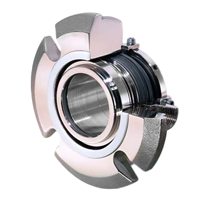
Mechanical seals (conventional and cartridge) offer an alternative to packing. Over the years, advancements made to face materials and elastomer selections have played an important role in mechanical seals becoming a more superior option.
Conventional seals are not without their challenges, however. Conventional seals require the operator to set and align the seal on the shaft or sleeve of the pump, a task that is difficult to say the least. This can increase margin for error resulting in premature failure. With reducing maintenance costs and downtime becoming highly valued assets in manufacturing, cartridge seals are quickly becoming the seal of choice. Continue reading to learn about cartridge seals, installation, and some things to remember.
 WHAT IS A CARTRIDGE SEAL?
WHAT IS A CARTRIDGE SEAL?
Untrained operators and installation errors are some of the reasons seals fail prematurely. To help operators overcome the fitting and installation problems associated with conventional seals, cartridge seals were developed. Cartridge seals are self-contained units consisting of a shaft sleeve, seal, and gland plate. The design of the cartridge seal works to eliminate common causes of seal failure from installation errors, and because the seal is presented on its own shaft sleeve, any damage that might be caused by a conventional seal to the pump unit is eliminated.
INSTALLING A CARTRIDGE SEAL
It's pretty simple actually: Slide the cartridge seal over the shaft as the pump is being built, align the gland ports, finish building the pump, evenly tighten the gland, tighten the collar set screws, and remove the spacers. Easy, right? The cartridge unit is fitted onto the pump shaft as a whole, pre-built assembly, which requires no further fitting adjustments (when compared to conventional seal installation procedures). The most common mistake we see is mechanics attaching the cartridge seal to the seal chamber BEFORE installing it on the pump - wrong!
Since the cartridge seal does not require the usual setting measurements and adjustments, maintenance costs are lowered and seal installation errors are minimized leading to more optimal seal life.
THINGS TO REMEMBER:
When using cartridge seals, make sure the unit is in good operating condition to minimize any future problems, such as a leak after the seal installation. Check the following:
And, most importantly, cartridge seals offer a level of standardization no matter what OEM machine is being sealed. When switching from conventional to cartridge, a drop off in seal performance should NOT be expected.
If you have questions about mechanical seals, contact us today! Your message will be routed to the appropriate Engineer for review. We're happy to provide assistance to businesses throughout Wisconsin and upper Michigan.
These Stories on Mechanical Seals
Headquarters and Service Center
Located outside Green Bay, WI
707 Ford Street
Kimberly, WI 54136
920-733-4425
OptiFlow Design and Build Center
1002 Truman Street
Kimberly, WI 54136
920-733-4425
Burnsville Service Center
12265 Nicollet Avenue
Burnsville, MN 55337
952-444-1949
Grand Rapids Service Center
26489 Industrial Blvd
Cohasset, MN 55721
952-444-1949
© Copyright 2024. Crane Engineering. All Rights Reserved. Privacy Policy.